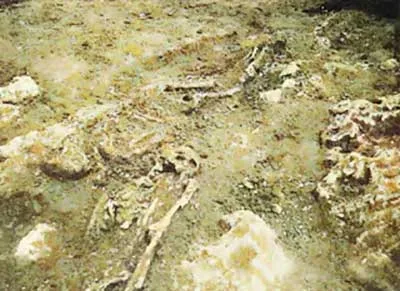Chinese Ceramics and Evidence of Violence in the Early Calatagan Excavations
In the 1930s, while ground was being leveled for use as an airstrip in the Municipality of Calatagan on the western side of the Province of Batangas, broken pieces of Chinese ceramics — called potsherds — were discovered1. Enrico and Jacobo Zobel of the family that owned the hacienda where the potsherds were found donated these to the Manila Museum, presumably what was then known as the National Museum of the Philippine Islands2.
The discovery of the potsherds was brought to the attention of the Swedish archeologist Robert Ture Olov Janse, at the time known for his excavations in French Indochina3. Janse had already conducted excavations in the Philippines under the sponsorship of Harvard University and his work in the country had the official support of no less than the President of the Commonwealth, Manuel L. Quezon.
Early in 1940, Janse had made arrangements with the Zobels for the systematic excavation of sites near the area called “Penagpatayan4,” where the potsherds had earlier been discovered. Before long, three ancient burial grounds were discovered. All these burial sites were very close to the shore.
The first burial ground was on Penagpatayan itself, “located on a natural mound with gently sloping sides.” The second was found in a place called Pulong Bacao (Bakaw), “on a flat promontory about one kilometer from Penagpatayan.” The final site was on another flat promontory surrounded by swamps in a place called Kay Tomas.
 |
| Remains found at an excavation site in Calatagan. Image from the 1946 edition of the Smithsonian Annual Report. |
In all, a total of sixty-six (66) tombs were found in the three burial grounds — 29 at Penagpatayan, 6 at Pulong Bacao and 31 at Kay Tomas. The skeletal remains found in the tombs at the latter two sites were generally in a poor state of preservation. At Penagpatayan, however, the limestone ground was seen as having been instrumental to the relatively good preservation of the skeletal remains.
Janse, after initial examination of the graves and the way these had been arranged at the Penagpatayan site, conjectured that many of the bodies might have been buried at the same time. Moreover, some of the skeletal remains showed signs of mutilation — e.g. missing arm, thorax or skull — suggesting that some sort of massacre might have taken place.
The most compelling sign of violence, however, was that several of the skeletal remains did not have skulls with them. Janse likewise conjectured that the remains belonged to victims of headhunters, and that this hypothetical massacre might have been the reason why the site was called Penagpatayan.
It was not only at Penagpatayan, however, where the skeletal remains showed signs of violence. At the Kay Tomas site, two of the skeletons had the skulls placed at the feet of the remains.
 |
| Example of ceramic unearthed in Calatagan. Image from the 1946 edition of the Smithsonian annual report. |
In the many of the tombs with the skeletons were discovered pieces of Chinese ceramics from the Ming Dynasty, the ruling dynasty in China from 1368 to 16445. These included earthenware, glazed small jars or bottles, bowls, saucers and dishes of glazed porcelain.
The ceramic industry in China was believed to have achieved one of its peaks during the Ming Dynasty, although arts and crafts that were exported outside of China, including those excavated in Calatagan were not always of the same high quality.
Apart from ceramics, also found in the graves were spindle whorls — discs used to increase the speed of spindles — a bracelet and knives. There were also implements found such as stone axes, pounders, pestles, grinding stones, flakes from volcanic rock and net sinkers6.
The increasing global tensions in 1940 meant that Janse had to fly out to the United States, something which also meant that the excavations in Calatagan had to be temporarily shelved. These resumed after the end of World War II, and by 1959, there were eleven excavation sites.
In addition to Penagpatayan, Kay Tomas and Pulong Bacao, new sites were excated at Punta Sunog, Layon, Balong Bato, Palatpat, Dayap, Punta Buwaya, Balitok and Parola7.
2 What is now known as the “National Museum of the Philippines” was created in 1928 as the “National Museum of the Philippine Islands,” placed under the supervision of the Department of Agriculture and Natural Resources. “History of the National Museum,” online at the Official Gazette of the Philippine Government.
3 “Olov Janse,” Wikipedia.
4 In contemporary Filipino/Tagalog, the spelling is “Pinagpatayan,” literally “where the killing took place.”
5 “Ming Dynasty,” Wikipedia.
6 A “net sinker” was stone or terra cotta used as weights to make fishing nets sink in the water.
7 “A Reconstruction of 15th Century Calatagan Community,” by Angelo G. Bernardo, online at Asian Ethnology.
Notes and references:
1 Unless otherwise indicated, information in this article was taken from “Archeology of the Philippines Islands,” published in the “1946 Annual Report of the Smithsonian Institution.2 What is now known as the “National Museum of the Philippines” was created in 1928 as the “National Museum of the Philippine Islands,” placed under the supervision of the Department of Agriculture and Natural Resources. “History of the National Museum,” online at the Official Gazette of the Philippine Government.
3 “Olov Janse,” Wikipedia.
4 In contemporary Filipino/Tagalog, the spelling is “Pinagpatayan,” literally “where the killing took place.”
5 “Ming Dynasty,” Wikipedia.
6 A “net sinker” was stone or terra cotta used as weights to make fishing nets sink in the water.
7 “A Reconstruction of 15th Century Calatagan Community,” by Angelo G. Bernardo, online at Asian Ethnology.
